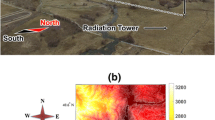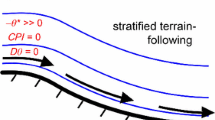Abstract
The effects of orography and initial stability upon the magnitude and configuration of daytime, valley-side slope flows were investigated. A three-dimensional, time-dependent, non-hydrostatic numerical model provided simulations over a range of idealised valley forms for a range of vertical stabilities. The model's short-wave radiation scheme was improved and the runs were for a virtually dry atmosphere. Airflow over the valley is influenced by two distinct stability regimes, separated by a sharp threshold value of 0.37°C km−1. At lower stabilities, flow is strong and predominantly downward. Above the threshold, uplift occurs for all stabilities, decreasing in magnitude with increasing stability. Cross-valley flow increases in the stability range 0.06°C–0.6°C/100 m and decreases at higher stabilities. For a given stability above the threshold value, vertical velocities are directly related to slope angle. Horizontal velocities increase with slope at low angles but there is a suggestion that they decrease with increasing slope angle at high angles. The effect of valley half-width is much smaller than that of slope; greater valley width leads to a weaker cross-valley circulation. Conditions for the development of valley-slope flow configuration in harmony with the underlying orography are derived. A quantitative relationship between the magnitude of the average flow and the average slope and the initial stability is presented.
Similar content being viewed by others
References
Anderson, D. J.: 1981, ‘The Katabatic Wind Field and Nocturnal Inversions in Valleys: A Two Dimensional Model’, Report No.1, Dept. Meteorology, Univ. of Bergen, Norway, 34 pp.
Anthes, R. A. and Warner, T. T.: 1978, ‘Development of Hydrodynamical Models Suitable for Air Pollution and Other Mesometeorological Studies’,Mon. Weath. Rev. 106, 1045–1078.
Atkinson, B. W.: 1981,Meso-scale Atmospheric Circulations, Academic Press, 495 pp.
Bader, D. C.: 1985, ‘Meso-scale Boundary Layer Development over Mountainous Terrain’,Atmos. Sci. Pap. 396. Dept. Atmos. Sci., Col. State Univ., Ft. Collins, Col., 251 pp.
Banta, R. M.: 1984, ‘Daytime Boundary Layer Evolution over Mountainous Terrain. Part 1. Observations of the Dry Circulations’,Mon. Weath. Rev. 112, 340–356.
Banta, R. M.: 1986, ‘Daytime Boundary Layer Evolution over Mountainous Terrain. Part 2. Numerical Studies of Upslope Flow Duration’,Mon. Weath. Rev. 114, 1112–1130.
Bell, R. C. and Thomson, R. O. R. Y.: 1980, ‘Valley Ventilation by Cross Winds’,J. Fluid. Mech. 96, 757–767.
Blumen, W.: 1990, ‘Atmospheric Processes over Complex Terrain’,Meteorol. Monog. 23(45), Amer. Met. Soc., 323 pp.
Carlson, J. D. and Foster, M. R.: 1986, ‘Numerical Study of Some Neutrally and Stably-Stratified Boundary Layer Flows over a Valley at Small Richardson Number’,Tellus 38A, 60–75.
Carpenter, K. M.: 1979, ‘An Experimental Forecast using a Non-hydrostatic Meso-scale Model’,Quart. J. R. Meteorol. Soc. 105, 629–656.
Clark, T. L.: 1977, ‘A Small-scale Dynamical Model using Terrain-following Coordinate Transformation’,J. Computational Physics 24, 186–215.
Clements, W. E. (ed.): 1989, ‘Atmospheric Studies in Complex Terrain’,J. Appl. Meteorol. 28, 405–689.
Defant, F.: 1949, ‘Zur theorie der Hangwinde nebst Bermerkungen zur Theorie der Bergund Talwinde’,Arch. Met. Geophys. Bioklim A (1), 421–450.
Egger, J.: 1981a, ‘On the Linear Two-dimensional Theory of Thermally Induced Slope Winds’,Beit. Phys. Atmos. 54, 465–481.
Egger, J.: 1981b, ‘Thermally Forced Circulations in a Valley’,Geophys. Astrophys. Fluid Dynamics 17, 255–279.
Egger, J.: 1990, ‘Thermally Forced Flows: Theory’, in W. Blumen (ed.),Atmospheric Processes over Complex Terrain, Meteorol. Monog. (Amer. Met. Soc.), Vol. 23, No. 45, pp. 43–58.
Estoque, M.: 1961, ‘A Theoretical Investigation of the Sea Breeze’,Quart. J. R. Meteorol. Soc. 87, 136–146.
Fast, J. D. and Takle, E. S.: 1988a, ‘Evaluation of an Alternative Method of Numerically Modelling Non-hydrostatic Flows over Irregular Terrain’,Boundary-Layer Meteorol. 44, 181–206.
Fast, J. D. and Takle, E. S.: 1988b, ‘Application of a Quasi-nonhydrostatic Paramaterization for Numerically Modelling Neutral Flow over an Isolated Hill’,Boundary Layer Meteorol 44, 285–305.
Gal-Chen, T. and Somerville, R. C. J.: 1975, ‘Numerical Solution of the Navier-Stokes Equations with Topography’,J. Computational Physics 17, 276–310.
Garnier, B. J. and Ohmura, A.: 1968, ‘A Method of Calculating the Direct Shortwave Radiation Income of Slopes’,J. Appl. Meteorol. 7, 796–800.
Garrett, A. J.: 1983, ‘Drainage Flow Prediction with a One-dimensional Model Including Canopy, Soil and Radiation Parameterization’,J. Clim. Appl. Meteorol. 22, 79–91.
Garrett, A. J. and Smith, F. G.: 1984, ‘Two-dimensional Simulations of Drainage Winds and Diffusion Compared to Observations’,J. Clim. Appl. Meteorol. 23, 597–610.
Gleeson, T. A.: 1951, ‘On the Theory of Cross-valley Winds Arising from Differential Heating of the Slopes’,J. Meteorol. 8, 398–405.
Gross, G.: 1988, ‘A Numerical Estimation of the Deforestation Effects on Local Climate in the Area of the Frankfurt International Airport’,Beitr. Phys. Atmos. 61, 219–231.
Gross, G., Vogel, H. and Wipperman, F.: 1987, ‘Dispersion over and Around a Steep Obstacle for Varying Thermal Stratification — Numerical Simulations’,Atmos. Envir. 21, 483–490.
Heilman, W. and Dobosy, R.: 1985, ‘A Nocturnal Atmospheric Drainage Flow Simulation Investigating the Application of One-dimensional Modelling and Current Turbulence Schemes’,J. Clim. Appl. Meteorol. 24, 924–936.
Hughes, R. L.: 1978, ‘A Numerical Simulation of Meso-scale Flow over Mountainous Terrain’,Atmos. Sci. Pap. 303, Dept. Atmos. Sci., Colorado State Univ., Ft. Collins, 30 pp.
Klemp, J. B. and Wilhelmson, R. B.: 1978, ‘The Simulation of Three-dimensional Convective Storm Dynamics’,J. Atmos. Sci. 35, 1070–1096.
Kondo, J. and Okusa, N.: 1990, ‘A Simple Numerical Prediction Model of Nocturnal Cooling in a Basin with Various Topographical Parameters’,J. Appl. Meteorol. 29, 604–619.
Magata, M. and Orgura, S.: 1967, ‘On the Airflow over Mountains under the Influence of Heating and Cooling’,J. Meteorol. Soc. Jap 45, 83–95.
Mahrer, Y. and Pielke, R. A.: 1971, ‘A Numerical Study of Airflow over Irregular Terrain’,Contrib. Phys. Atmos. 50, 98–113.
Mahrer, Y. and Pielke, R. A.: 1975, ‘A Numerical Study of the Airflow over Mountains using the Two-dimensional Version of the University of Virginia Mesoscale Model’,J. Atmos. Sci. 32, 2144–2155.
Mannouji, N.: 1982, ‘A Numerical Experiment on the Mountain and Valley Winds’,J. Meteorol. Soc. Jap. 60, 1085–1105.
Martin, C. L. and Pielke, R. A.: 1983, ‘The Adequacy of the Hydrostatic Assumption in Sea-breeze Modelling over Flat Terrain’,J. Atmos. Sci. 40, pp. 1472–1481.
Mason, P. J. and Derbyshire, S. H.: 1990, ‘Large-eddy Simulation of the Stably-Stratified Atmospheric Boundary Layer’,Boundary-Layer Meteorol. 53, 117–163.
McNider, R. T. and Pielke, R. A.: 1981, ‘Diurnal Boundary Layer Development over Sloping Terrain’,J. Atmos. Sci. 38, 2198–2212.
McNider, R. T. and Pielke, R. A.: 1984, ‘Numerical Simulation of Slope and Mountain Flows’,J. Clim. Appl. Meteorol. 23, 1441–1453.
Mellor, G. L. and Yamada, T.: 1982, ‘Development of a Turbulence Closure Model for Geophysical Fluid Problems’,Rev. Geophysics and Space Physics 20, 851–875.
Nicholls, M. E., Pielke, R. A. and Cotton, W. R.: 1991, ‘A Two-dimensional Numerical Investigation of the Interaction between Sea Breezes and Deep Convection over the Florida Peninsular’,Mon. Weath. Rev. 119, 298–323.
Orville, H. D.: 1964, ‘On Mountain Upslope Winds’,J. Atmos. Sci. 21, 622–633.
Pandolfo, J. P.: 1969, ‘Motions with Inertial and Diurnal Period in a Numerical Model of the Navifacial Boundary Layer’,J. Marine Sci. 27, 301–317.
Pielke, R. A.: 1972, ‘Comparison of a Hydrostatic and an Anelastic Dry Shallow Primitive Equation Model’,NOAA Tech. Mem. ERL OD-13, 47 pp.
Pielke, R. A.: 1974, ‘A Three Dimensional Numerical Model of the Sea-Breeze over South Florida’,Mon. Weath. Rev. 102, 115–139.
Pielke, R. A.: 1984,Mesoscale Meteorological Modelling, Academic Press, 612 pp.
Segal, M., Ookouchi, Y. and Pielke, R. A.: 1987, ‘On the Effect of Steep Slope Orientation on the Intensity of Daytime Upslope Flow’,J. Atmos. Sci. 44, 3587–3592.
Tapp, M. C. and White, P. W.: 1976, ‘A Non-hydrostatic Meso-scale Model’,Quart. J. R. Meteorol. Soc. 102, 277–296.
Thyer, N. H.: 1966, ‘A Theoretical Explanation of Mountain and Valley Winds by Numerical Method’,Archiv. fur Met. Geoph. und Bioklim. 17A, 318–347.
Tjemkes, S. A. and Duynkerke, P. G.: 1989, ‘The Nocturnal Boundary Layer: Model Calculations Compared with Observations’,J. Appl. Meteorol. 28, 161–175.
Tripoli, G. J. and Cotton, W. R.: 1982, ‘The Colorado State University Three-dimensional Cloud/Meso-scale Model: Part 1. General Theoretical Framework and Sensitivity Experiments’,J. Rech. Atmos. 16, 185–219.
Vergeiner, I.: 1987, ‘An Elementary Valley Wind Model’,Meteorol. and Atmos. Physics 36, 255–263.
Vogel, B., Gross, G. and Wipperman, F.: 1986, ‘MESOKLIP (First Special Observation Period): Observations and Numerical Simulation — A Comparison’,Boundary-Layer Meteorol. 35, 83–102.
Wallbaum, T.: 1982,Numerische Simulation Atmosphariskher Stromungen im Meso-scale Gamma, Ph.D. Dissertation, Technical Univ., Darmstadt, 185 pp.
Whiteman, C. D.: 1990, ‘Observations of Thermally Developed Wind Systems in Mountainous Terrain’, in W. Blumen (ed.)Atmospheric Processes over Complex Terrain. Meteorol. Monog. (Amer. Met. Soc.), Vol. 23, No. 45, pp. 5–42.
Wipperman, F.: 1984, ‘The Applicability of Several Approximations in Meso-scale Modelling — A Linear Approach’,Contrib. Atmos. Phys. 54, 298–308.
Xue, M. and Thorpe, A. J.: 1991, ‘A Meso-scale Numerical Model using the Non-hydrostatic Pressure Based Sigma Coordinate Equations: Model Experiments with Dry Mountain Flows’,Mon. Weath. Rev. 119, 1168–1185.
Yamada, T.: 1978,A Three Dimensional Numerical Study of Complex Atmospheric Circulations Produced by Terrain, Proc. AMS Conf. Sierra Nevada Meteorol, pp. 61–67.
Yamada, T. and Bunker, S.: 1989, ‘A Numerical Model Study of Nocturnal Drainage Flows with Strong Wind and Temperature Gradients’,J. Appl. Meteorol. 28, 545–554.
Yang, X.: 1991, ‘A Study of Non-hydrostatic Effects on Idealized Sea Breeze Systems’,Boundary-Layer Meteorol. 54, 183–208.
Ye, Z. J., Garrett, J. R., Segal, M. and Pielke, R. A.: 1990, ‘On the Impact of Atmospheric Thermal Stability on the Characteristics of Nocturnal Downslope Flows’,Boundary-Layer Meteorol. 51, 77–98.
Author information
Authors and Affiliations
Rights and permissions
About this article
Cite this article
Atkinson, B.W., Shahub, A.N. Orographic and stability effects on day-time, valley-side slope flows. Boundary-Layer Meteorol 68, 275–300 (1994). https://doi.org/10.1007/BF00705601
Revised:
Issue Date:
DOI: https://doi.org/10.1007/BF00705601




